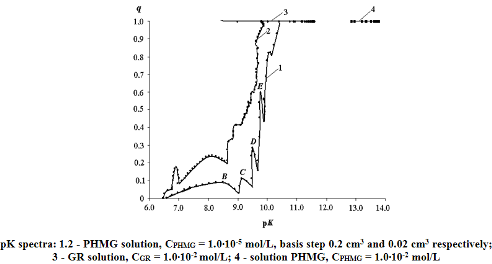Potentiometric analysis of chloride polyhexamethyleneguanide pK-spectroscopy
DOI:
https://doi.org/10.15421/081321Keywords:
potentiometer method, pK-spectrum, regression analysisAbstract
The mathematical analysis of data of titration of chloride polyhexamethyleneguanide (PGMG) containing repeating functional group, capable to a deprotonation carried out. For the characteristic of interparticle cooperation in system water - PGMG the method of pK-spectroscopy is offered for using. The metod based on the use of linear regression analysis with restrictions on the non-negative solutions. The experimental curve of electrometric titration of PGMG is received and transformed to function of distribution of ionogenic groups of titration object on sizes рК acid ionization (pK-spectrum). The method of pK-spectroscopy the possibility of using to predict the spatial structure and conformational transitions of polycations. The interrelation of constants of dissociations of PGMG and transition a globule-ball in water solutions is studied.
References
Garmash, A. V. Potentiometric analysis of polyelectrolytes by pK-spectroscopy using linear regression. Zhurn. Anal. Khim., 1998, vol. 53, no 4, p. 411-417.
Leuenberger, B., Schindler, P. W. Application of integral pK-spectrometry to the titration curve of ulvic acid. Anal. Chem., 1986, vol. 58, р. 1471-1474.
Cholin, U. V., Merniy, S. A. Description equilibria involving macromolecular ligands with a model of a continuous distribution of the equilibrium constants. Ukr. Khim. Zhurn., 1991, no. 7, p. 688-691.
Varshal, G. М. , Bugaevsky, А. А., Cholin, U. V. Modeling of equilibria in solutions of fulvic acids in natural waters. Khim. Tekhnol. Vody, 1990, vol. 12, no. 11, p. 979-983.
Garmash, A. V., Vorobyova, О. N. Validation results in potentiometric analysis polyelectrolyte pK spectroscopy methods. Zhurn. Anal. Khim., 1998, vol. 53, no. 3, p. 258-264.
Sobanov, A. A. Metodicheskie ukazaniya k kursu vyisokomolekulyarnyie soedineniya. Kazan: Kazan State University, 2007, 35 p.
Lawson, C., Henson, R. Chislennoe reshenie zadach metoda naimenshih kvadratov, Moscow: Nauka, 1986, 230 p.
Kudrev, A. G. Calculation of association constants in solution with polynucleotides. Vysokomol. Soedin., 2000, vol. 42, no. 5, p. 803-810.
Albert, A., Sergeant, Е. Konstantyi ionizatsii kislot i osnovaniy, Moscow: Khimiya, 1964., 179 p.
Garmash, A. V., Ustimova, I. V., Kudryavtsev, A. V. Potentiometric analysis of complex systems by protolytic pK spectroscopy using linear regression. Zhurn. Anal. Khim., 1998, vol. 53, no. 3, p. 241-248.
Mchedlov-Petrosyan, N. O. Differentsirovanie silyi organicheskih kislot v istinnyih i organizovannyih rastvorah, Kharkov: Publishing house of the V.N. Karazin Kharkov National University, 2004, 326 p.
Fukushima, M., Tanaka, S., Hasebe, K. Interpretation of the acid-base equilibrium of humic acid by a continuous pK distribution and electrostatic model. Anal. Chim. Acta. 1995, vol. 302, p. 365-373.
Shamrikova, E. V., Ryazanov, M. A., Vanchikova, E. V. Acid–base properties of water-soluble organic matter of forest soils, studied by the pK-spectroscopy method. Chemosphere, 2006, no. 65, p. 1426-1431.

Downloads
Published
Issue
Section
License
Copyright (c) 2014 Vìsnik Dnìpropetrovsʹkogo unìversitetu. Serìâ Hìmìâ

This work is licensed under a Creative Commons Attribution 4.0 International License.
- Authors reserve the right of attribution for the submitted manuscript, while transferring to the Journal the right to publish the article under the Creative Commons Attribution License. This license allows free distribution of the published work under the condition of proper attribution of the original authors and the initial publication source (i.e. the Journal)
- Authors have the right to enter into separate agreements for additional non-exclusive distribution of the work in the form it was published in the Journal (such as publishing the article on the institutional website or as a part of a monograph), provided the original publication in this Journal is properly referenced
- The Journal allows and encourages online publication of the manuscripts (such as on personal web pages), even when such a manuscript is still under editorial consideration, since it allows for a productive scientific discussion and better citation dynamics (see The Effect of Open Access).

